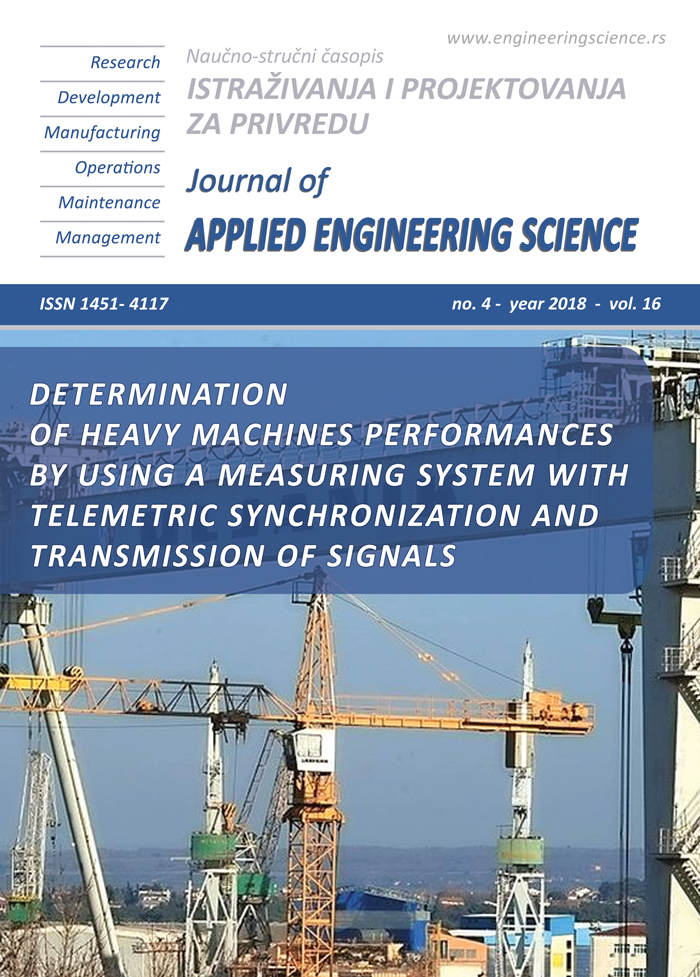SYNTHESIS OF EXOSKELETON CONTROL ALGORITHMS BASED ON KINEMATIC ANALYSIS OF LOCOMOTIONS AND HUMAN GAIT MODELLING
Abstract
The article considers a mathematical model of human walking. Walking parameters necessary to build an analytical model of motion are defined. Calculated ratio to define the coordinates of key points of legs at any moment of time is obtained and a kinematic analysis of locomotions is performed. The results of computer modelling of walking process are given. The calculated ratio and the mathematical model can be used for design process and programming of the operation of control systems of exoskeleton developed for medical purposes.
References
Hugh Herr. (2009) Exoskeletons and orthoses: Classification, design challenges and future directions. Journal of Neuro Engineering and Rehabilitation. 6(21):21. DOI: 10.1186/1743-0003-6-21
Vorobiev A.A., Petrukhin A.V., Zasypkina O.A., Krivonozhkina P.S. (2015) Ekzoskelet – no-vye vozmozhnosti abilitatsii i reabilitatsii (analitichesky obzor) [Exoskeleton is New Possibili-ties of Habilitation and Rehabilitation (Analytical Survey).] Voprosy rekonstruktivnoy i plas-ticheskoy khirurgii [Problems of Reconstructive and Plastic Surgery]. Vol. 18. No 2 (53). Pp. 51-62.
Cristian C. Velandia, Diego A. Tibaduiza, Maribel Anaya Vejar. Proposal of Novel Model for a 2 DOF Exoskeleton for Lower-Limb Rehabilitation // Robotics, MDPI. – 2017, 6 (20). Р. 1- 25. doi:10.3390/robotics6030020
Liu D. X., Wu X., Du W., Wang C., Chen C., and Xu T., (2017) Deep spatial-temporal model for rehabilitation gait: optimal trajectory generation for knee joint of lower-limb exoskeleton. Assembly Automation, vol. 37, no. 3, pp. 369–378. https://doi.org/10.1108/AA-11-2016-155
Sado F, Yap HJ, Ghazilla RAR, Ahmad N (2018) Exoskeleton robot control for synchronous walking assistance in repetitive manual handling works based on dual unscented Kalman fil-ter. PLoS ONE 13(7): e0200193. https://doi.org/10.1371/journal.pone.0200193
Chen J., Mu X., Du F. (2017) Biomechanics analysis of human lower limb during walking for exoskeleton design. Journal of Vibroengineering, Vol. 19, Issue 7, Р. 5527-5539. https://doi.org/10.21595/jve.2017.18459 или https://www.jvejournals.com/article/18459
Chen Q., Cheng H., Yue C., Huang R., and Guo H. (2018) Dynamic Balance Gait for Walk-ing Assistance Exoskeleton. Applied Bionics and Biomechanics. Volume 2018, 10 p. Article ID 7847014, https://doi.org/10.1155/2018/7847014
Loskutov Yu. V., Kapustin A. V., Klyuzhev K. S., Kudryavtsev A. I., Loskutov M. Yu., Fadeev A. M. (2017) Coputer Simulation of Regular Walking Based on the Kinematic Analy-sis of Movements and the Synthesis of Exoskeleton Control Algorithms. Vestnik of Volga State University of Technology. Ser.: Radio Engineering and Infocommunication Systems.. No 3 (35). Pp. 47-60. DOI: 10.15350/2306-2819.2017.3.47
Winter, David A., Biomechanics and motor control of human movement / David A. Winter. – JOHN WILEY & SONS, INC., 2009 – 370 p. ISBN 978-0-470-39818-0 (cloth)
Michael Oluwatosin Ajayi. Modelling and control of actuated lower limb exoskeletons : a mathematical application using central pattern generators and nonlinear feedback control tech-niques. General Mathematics [math.GM]. Université Paris-Est, 2016. English. https://tel.archives-ouvertes.fr/tel-01531927
Skvortsov, D.B., Diagnostics of the motion activity with instrumental methods: gait analysis, stabilometry / D.V. Skvortsov. – М.: Т.М. Andreeva. 2007. – 640 p.
Kapandzhi, A.I. Nizhnyaya konechnost: Funktsional’naya anatomiya [Lower Limb: Physio-logical Anatomy] / A.I. Kapandzhi; preface Prof. Thierry Judet; [Translation from French G. Abeleva, E. Kishenevsky]. Moscow: Publishing house «E»2017. 352 p. ISBN 978-5-699-43912-6.
Mark L. Latash, Vladimir Zatsiorsky. Biomechanics and Motor Control: Defining Central Concepts. – Elsevier, Academic Press, 2016. – p. 426.
T. Koolen, T. D. Boer, J. Rebula, A. Goswami, and J. Pratt. (2012) Сapturability-based analy-sis and control of legged locomotion, part 1: theory and application to three simple gait mod-els. The International Journal of Robotics Research, vol. 31, no. 9, pp. 1094–1113. https://doi.org/10.1177/0278364912452673
J. Pratt, T. Koolen, T. D. Boer et al., (2012) Capturability-based analysis and control of legged locomotion, part 2: application to m2v2, a lower-body humanoid. The International Journal of Robotics Research, vol. 31, no. 10, pp. 1117–1133. https://doi.org/10.1177/0278364912452762
Kolesnikova G.P., Formalsky A.M. (2014) Ob odnom sposobe modelirovaniya pokhodki che-loveka [About One Method of Human Gait Modeling]. Inzhenernyy zhurnal: nauka i inno-vatsii [Engineering Journal: Science and Innovations] No 1 (25). P. 11. http://engjournal.ru/catalog/eng/teormech/1181.html. (reference data 10.07.2017).
Apaleeva A.M. (2012) Razrabotka algoritma issledovaniya kinematiki dvizheniya cheloveka [Development of the Research Algorithm of Human Motion Kinematics]. Vestnik Amurskogo gosudarstvennogo universiteta. Seriya: Estestvennye i ekonomicheskie nauki [Vestnik of Amur State University. Series: Natural and Economic Sciences]. No 59.Pp. 12-17.
The objective assessment of the gait function: clinical recommendations / D.V. Skvortsov and others. – M.: Stroke struggle National Association, Rehabilitation Union of the RF, Russian Association for sport medicine and rehabilitation of disabled people, Interregional Public Or-ganization “Union of Neuroanesthesia and neuroresuscitation specialists”, 2016. – 25 p.

